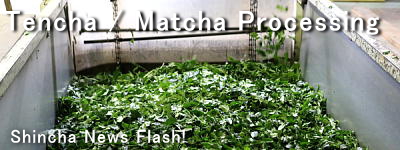Dear Sir and Madam,
We at Hibiki-an THANK YOU VERY MUCH for your continued patronage and support.
We are pleased to offer useful information for your healthy life and continued
enjoyment of Japanese green tea. In this issue, we talk about 'Shincha News Flash! (Tencha / Matcha Processing)'.
|
Share
|

|

|
We have been following the green tea sprouts from early spring when the tea trees put out their first new buds to the harvest of Shincha, the first tea of the year. Now, we bring you the latest breaking news and information from Hibiki-an's tea farm in Ujitawara in Kyoto!
Around June 6: (Tencha / Matcha Processing)
 |
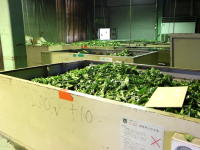 |
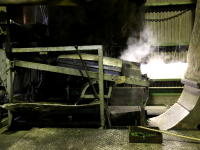 |
| Cargo truck carrying tea sprouts just after harvested |
Tea sprouts just after harvested are waiting for processed in container. The container is air-conditioned in order to prevent heat damage. |
Steaming process |
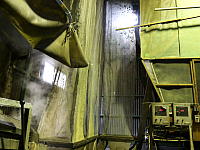 |
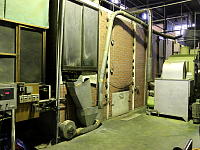 |
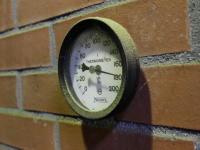 |
| Blown upward by a blast of air, the tea leaves soar upward about 6m (19.68ft) and are quickly cooled. |
Tea leaves dry in a three or five level fire pit, heated from underneath by a burner. |
The temperature inside the fire pit is carefully controlled. |
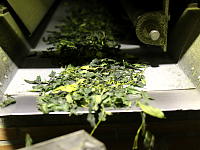 |
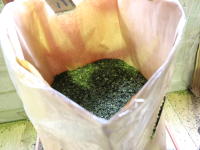 |
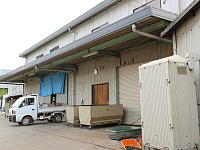 |
| Tea leaves emerging from the fire pit |
Tencha Aracha just after sorted. It is called Aracha Tencha. |
Before Tencha is ground into Matcha powder, the tea is known as Aracha of Tencha. |
Fresh tea leaves are processed just after harvest. At the most, they should be processed within 24 hours after harvest. Tencha (Matcha) processing includes 1) Steaming, 2) Cooling down, 3) Drying, and 4) Cutting / Sorting. Matcha tea leaves before ground into powder are called Tencha.
1) Steaming:
Fresh tea leaves just after harvest are steamed for 30 to 40 seconds. The steaming process stops oxidation (fermentation). Steaming temperature and steaming time should be adjusted by the condition of the tea leaves. The steaming process is one of the most important steps and determines the quality of the finished tea.
2) Cooling down:
Steamed tea leaves are quickly cooled by a strong blast of air. This fast cooling process extracts the aroma and bright color of tea leaves. Blown upward by the blast of air, the tea leaves soar upward about 6m (19.68ft).
3) Drying:
During this step, the tea leaves are dried in a fire pit. Inside of the fire pit is a three or four level structure, heated from underneath by a burner. The temperature of each layer is carefully controlled from 110 to 180C (230 to 356F). Before entering the fire pit, tea leaves are distributed evenly across a conveyor belt so that they dry consistently. There should be no overlap. Tea leaves pass through all levels of the fire pit to dry for about 20 minutes. This drying process determines the aroma and taste of Tencha (Matcha).
4) Cutting / Sorting:
After emerging from the fire pit, the tea leaves are cut and sorted to determine if they are dry enough. Thicker sections of the tea leaf such as stems and veins may not be completely dry, and are dried again in the fire pit. Finally, the cut and dry tea leaves are mixed thoroughly to ensure consistent quality and flavor. At this point, before Tencha is ground into Matcha powder, the tea is known as Aracha of Tencha.
Shincha teas:
Shincha is now available. We have arranged to add four limited edition Shincha items only available this Shincha harvest season, featuring a few regular Sencha items with especially enjoyable Shincha flavor. Celebrate our first tea harvest of the year with Hibiki-an's Shincha and enjoy the remarkable fresh flavor, which can only be experienced once every year!
What is Shincha?: click here
The Matcha and Gyokuro harvest started around May 20. Traditionally, Matcha
and Gyokuro are aged for several months after harvest to gain a more complex,
enriched flavor. However, today's tea connoisseurs desire the fresh flavor
of Matcha and Gyokuro just after harvest.
At last we have arranged Shincha Matcha with an amazing flavor that is
not only refreshing but also deeply smooth and mellow, so our customers
can try this fresh new style of Matcha.
We are also pleased to offer Shincha Gyokuro, which is now available. Would you try the refreshing aroma and smooth, mellow taste of Shincha Matcha and Shincha Gyokuro which can be enjoyed only at harvest time?

|
|
(Now Available)
Recently, Shincha Matcha is enjoyed mainly among teachers or masters of tea ceremony. They enjoy the fresh flavor of Shincha Matcha. And they feel delight of the spring season, inspired by the fresh flavor of Shincha Matcha....
|

|
|
(Now Available)
This Shincha Matcha Refill package is an excellent value. The price is actually discounted 20%. Over time, the refreshing aroma will moderate and the flavor will enrich, so that you can enjoy a subtle variation of aroma and flavor with each refill...
|

|
|
(Now Available)
With our Shincha Gyokuro you can enjoy both the refreshing aroma of Shincha and the mellow smooth taste of Gyokuro in one cup of tea. In the tea industry, it is called "Kabuse Cha"...
|
Customer Reviews of Shincha Matcha: click here
Customer Reviews of Shincha Gyokuro: click here
At last, the Shincha Harvest started here in the Uji region!
Shincha teas are now available. We have arranged to add four limited edition Shincha items only available this Shincha harvest season, featuring a few regular Sencha items with especially enjoyable Shincha flavor. And other Sencha regular items are planned to be replaced later by Shincha step by step.
Celebrate our first tea harvest of the year with Hibiki-an's Shincha and enjoy the remarkable fresh flavor which can only be experienced once every year!
Limited edition Shincha teas
All four Shicha teas below are limited edition of 1,200 packages each ONLY
AVAILABLE this harvest season. We have arranged various types of Shincha,
which will be specially finished to enjoy Shincha's refreshing aroma and
flavor.
We hope you will enjoy the refreshing aroma and smooth flavor of Shincha!

|
|
(Now Available)
These tea leaves are finished in the traditional Uji/Kyoto style. Therefore
the astringent refreshing aroma and mellow flavor are prominent, and the
harmony is excellent...
|

|
|
(Now Available)
Saemidori breed brings us pleasure in the springtime, to consider the unique flavor and early-ripening. Enjoy the sweet and smooth taste unique to this tea, as well as the fresh aroma...
|

|
|
(Now Available)
Enjoy the natural taste and refreshing aroma of this "Aracha" Shincha at an affordable price. "Aracha" is unprocessed tea that Japanese farmers have been enjoying for centuries...
|

|
|
With our Shincha Gyokuro you can enjoy both the refreshing aroma of Shincha and the mellow smooth taste of Gyokuro in one cup of tea. In the tea industry, it is called "Kabuse Cha"...
|

|
|
(Now Available)
Recently, Shincha Matcha is enjoyed mainly among teachers or masters of tea ceremony. They enjoy the fresh flavor of Shincha Matcha. And they feel delight of the spring season, inspired by the fresh flavor of Shincha Matcha....
|

|
|
(Now Available)
This Shincha Matcha Refill package is an excellent value. The price is actually discounted 20%. Over time, the refreshing aroma will moderate and the flavor will enrich, so that you can enjoy a subtle variation of aroma and flavor with each refill...
|
Regular Sencha teas with especially enjoyable Shincha flavor
For pre-orders, we chose three regular teas especially recommended to enjoy
Shincha's remarkable refreshing aroma and fresh and smooth flavor.

|
|
(Now Available)
Sencha Pinnacle, which is the highest quality Sencha produced in Japan,is the same type of tea which has been presented to the Japanese emperor
for many years. This item is grown at the same tea farm with tea that has
been presented to the Japanese Emperor, and harvested in the same way,
picked by skilled hands...
|

|
|
(Now Available)
Sencha Super Premium, along with our Sencha Pinnacle, is the highest quality Sencha produced in Japan. Each leaf is specially selected and carefully picked by our farmers' skilled hands. With this special tea, you can enjoy the same Shincha flavor enjoyed by Japanese Emperors...
|

|
|
(Now Available)
Organic Sencha's harvest generally starts 7 to 10 days later than conventional grown Sencha. The feature of the flavor is very simple and traditional. We imagine that the Shincha flavor enjoyed hundreds of years ago in historical Japan was just like this. Would you enjoy the simple Shincha flavor that was enjoyed long, long ago?...
|
What is Shincha?: click here
Replacement Status of Regular Teas by New Crop: click here
Are you enjoying your green moments? Hibiki-an encourages those who love
to drink green tea. If you have any requests or questions regarding our
teas or services, please don't hesitate to contact us. We sincerely hope
that you enjoy genuine Hibiki-an Japanese green tea direct to you from
Kyoto, Japan.
Sincerely yours,
Atsushi Yasui
We have arranged for 10 limited edition, and two new Matcha Starter Sets.
The 10 limited edition Matcha Bowl are all available only this spring and
summer season.
Some of the items are designed with modern, sophisticated style, while others use traditional handcrafted techniques for a more traditional design.
We have chosen items that are of exceptional quality yet reasonable in price. They will certainly enrich and enhance your green moment.

|
|
HAJIRAI of this name means bashfulness in Japanese. White glaze and pink color on the base, both outside and inside, and its unique form, remind us of the blush of a maiden. It also reminds us of the breezy and carefree springtime...
|

|
|
This Matcha bowl is graceful and dignified. The combination of the paintings and the decoration of gold brings an extremely elegant atmosphere. The harmony and contrast of natural soil and the elegant decoration are very rare and unique...
|

|
|
ORIBE is a green color used in traditional pottery. MENTORI describes the surfaces created by carving away the clay. The traditional green color glaze, ORIBE green, is named after historical tea master, Oribe Furuta...
|

|
|
This porcelain Matcha Bowl creates an aura of elegance and unique pleasant cooling sensation. HANA of this name means flower and KESSHO means crystal in Japanese. This item is finished by the technique called Crystal glaze...
|

|
|
AYAME of this name means iris in Japanese. Traditional drawing patterns on this Matcha Bowl are dynamically and elegantly shaped with a unique and ingenious form. Orange patches called GOHONDE deepen the atmosphere...
|

|
|
KYO of this name means KYOTO and HARU means spring in Japanese. SAKURA cherry blossoms, painted on this Matcha Bowl, are well-loved flowers, symbolizing springtime, in Japan. Considering the price and quality, this Matcha bowl is an outstanding value...
|

|
|
This Matcha bowl is one of the most traditional and standard called IRABO CHAWAN. This style features a yellow IRABO glaze and the typical form called IDO GATA...
|

|
|
This Matcha Bowl has a tranquil, elegant, and a little cute atmosphere, and when held in both hands, creates a calming effect. Matcha Bowl having such character is quite rare, but sought after...
|

|
|
HYO RETSU, which means cracked ice in Japanese, is a very traditional Japanese glazing technique. This technique intentionally creates an intricate network of thin surface cracks in the glaze...
|

|
|
This Starter Set is the minimum set including only the essential tea ware for a perfect bowl of Matcha. And this includes KYO no HARU handcrafted Matcha Bowl, painted elegantly by typical Kyo Yaki style...
|

|
|
This Starter Set is the minimum set including only the essential tea ware for a perfect bowl of Matcha. IRABO handcrafted Matcha Bowl and KUROCHIKU Banboo Whisk create the WABI SABI atmosphere...
|
Teapots / Cups shopping page: click here
Matcha Bowls / Accessories shopping category: click here
YOHKAN sweet bean jelly is one of the most popular and classic confections
in Japan along with OHIGASHI candy and OKAKI rice cracker. Indeed AN bean
jam, which is the main ingredient of YOHKAN, is the most essential ingredient
of WAGASHI traditional Japanese confections. It has a unique texture and
sweetness which pairs well with all kinds of Japanese tea.
We developed four flavors of YOHKAN with an established AN bean jam manufacturer
located in Kyoto. Our four flavors of YOHKAN are manufactured with careful
attention to quality and domestic ingredients...
(visit the shopping page: click here)
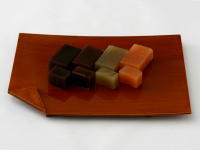 |
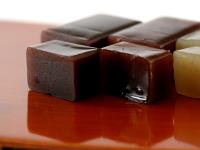 |
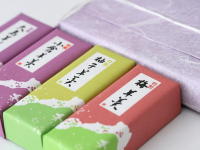 |
| Starting from the left to right, OHSHIMA, OGURA, YUZU, and UME |
|
Wrapped and decorated with WASHI Japanese paper |
YOHKAN (sweet bean jelly) US$17.50 shopping page: click here
Japanese Snacks / Candy shopping category: click here
(Notice) Our New Website / New Smartphone-optimized Website
We recently launched a brand new website to provide an enhanced customer experience. The new design enables you to navigate and interact with the site more easily, including:
- Finding and ordering items from your order history.
- Searching for items more easily in our tea and tea ware shop.
- Enjoying seasonal topics more easily.
Our new smartphone-optimized website launched too. Would you check once?
Account info
You can view your account info, including your order history, as well as change your email, password, or home address or add a new shipping address to your address book by clicking here.
Or if you prefer, we are happy to update your account info for you. Just let us know. Please don't hesitate to contact us!
To unsubscribe from Hibiki-an Newsletters
You can remove your email address from the mailing list by clicking here.
Or if you prefer, email us with your FULL NAME and we will immediately remove your email address from the mailing list.
Japanese Green Tea Hibiki-an
36 Shimonoto Yuyadani
Ujitawara, Kyoto 610-0221
Japan
http://www.hibiki-an.com
